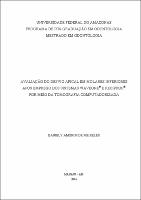| ???jsp.display-item.social.title??? |


|
Please use this identifier to cite or link to this item:
https://tede.ufam.edu.br/handle/tede/4059| ???metadata.dc.type???: | Dissertação |
| Title: | Avaliação do desvio apical em molares inferiores após emprego dos sistemas Waveone® e Reciproc® por meio da tomografia computadorizada |
| ???metadata.dc.creator???: | Meireles, Daniely Amorim de  |
| ???metadata.dc.contributor.advisor1???: | Sponchiado Junior, Emílio Carlos |
| ???metadata.dc.description.resumo???: | O objetivo deste estudo foi avaliar por meio de exame tomográfico a ocorrência e direção do desvio apical, a capacidade de centralização e a porcentagem de aumento de área após instrumentação de canais radiculares com sistemas do Grupo Reciproc® (GR) e do Grupo WaveOne® (GWO). Vinte e seis molares inferiores com grau de curvatura de 20°≤40° e raio ≤10 mm, comprimento radicular de 16 mm, diâmetro apical referente a lima K #15 e forames independentes foram utilizados. Após inclusão em resina acrílica autopolimerizável, os dentes foram separados aleatoriamente em dois grupos (n=13): GWO - preparo biomecânico dos canais mesiais com sistema WaveOne® e GR - preparo biomecânico dos canais mesiais com sistema Reciproc®. O desvio apical e a sua direção foram avaliados a partir da fórmula D=(X1-X2)-(Y1-Y2). A capacidade de centralização foi analisada por meio da fórmula CC=(X1-X2/Y1–Y2 ou Y1–Y2/X1-X2), e o aumento percentual da área foi calculado a partir da diferença entre a área do canal instrumentado e não instrumentado. GR apresentou os maiores valores de desvio apical, no entanto, sem diferença estatisticamente significante em relação a GWO (P > .05). Ambos os sistemas proporcionaram maior tendência de transporte no sentido mesial. Ambos os grupos não apresentaram perfeita centralização, com valores similares estatisticamente (P >.05). Já o aumento percentual da área pós-instrumentação não apresentou diferença significante entre os grupos (P > .05). Ambos os sistemas promoveram alteração mínima da morfologia do canal radicular. |
| Abstract: | The aim of this study was to evaluate, by means of tomographic exam, the occurrence and direction of apical deviation, capacity of centralization and percentage of area after root canal instrumentation with the Reciproc® and WaveOne® systems. Twenty-six mandibular molars with a degree of curvature of 20°≤40° and radius ≤10 mm, root length of 16 mm, apical diameter with reference to file K #15 and independent foramina were used. After embedment in self-polymerizing acrylic resin, the teeth were randomly distributed into two groups (n=13): WOG system – biomechanical preparation of mesial canals with WaveOne® and RG systems - biomechanical preparation of mesial canals with Reciproc® system. The apical deviation and its direction were evaluated using the formula D=(X1-X2)-(Y1-Y2). The capacity of centralization was analyzed by means of the formula CC=(X1-X2/Y1–Y2 or Y1– Y2/X1-X2), and the percentage increase in area was calculated from the difference between the area of the instrumented canal and that of the non-instrumented canal. RG presented the highest apical deviation values, however without statistically significant difference in comparison with WOG (P > .05). Both systems showed greater tendency towards transport in the mesial direction. None of the groups presented perfect centralization, with statistically similar values (p = 0.05). While the percentage increase in post instrumentation area presented no significant difference between the groups (P >.05). Both systems promoted minimal alteration in the root canal morphology. |
| Keywords: | Desvio Apical Reciproc WaveOne Apical Deviation |
| ???metadata.dc.subject.cnpq???: | CIÊNCIAS DA SAÚDE: ODONTOLOGIA |
| Language: | por |
| ???metadata.dc.publisher.country???: | Brasil |
| Publisher: | Universidade Federal do Amazonas |
| ???metadata.dc.publisher.initials???: | UFAM |
| ???metadata.dc.publisher.department???: | Faculdade de Odontologia |
| ???metadata.dc.publisher.program???: | Programa de Pós-graduação em Odontologia |
| Citation: | MEIRELES, Daniely Amorim de. Avaliação do desvio apical em molares inferiores após emprego dos sistemas Waveone® e Reciproc® por meio da tomografia computadorizada. 2014. 120 f. Dissertação (Mestrado em Odontologia) - Universidade Federal do Amazonas, Manaus, 2014. |
| ???metadata.dc.rights???: | Acesso Aberto |
| URI: | http://tede.ufam.edu.br/handle/tede/4059 |
| Issue Date: | 24-Jan-2014 |
| Appears in Collections: | Mestrado em Odontologia |
Files in This Item:
| File | Description | Size | Format | |
|---|---|---|---|---|
| Dissertação -Daniely Amorim de Meireles.pdf | Dissertação -Daniely Amorim de Meireles | 13.27 MB | Adobe PDF |  Download/Open Preview |
Items in DSpace are protected by copyright, with all rights reserved, unless otherwise indicated.




